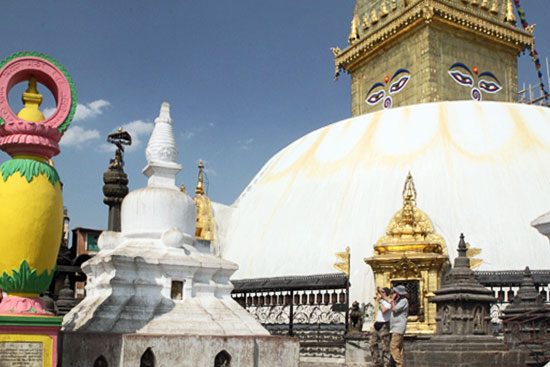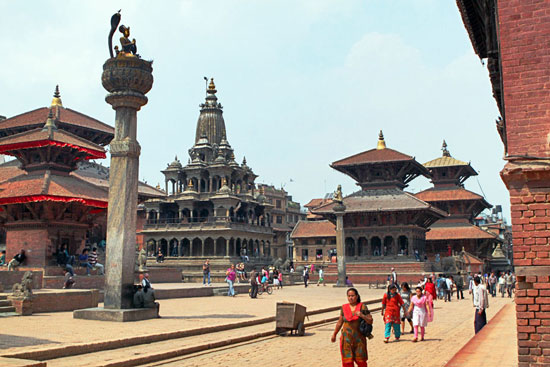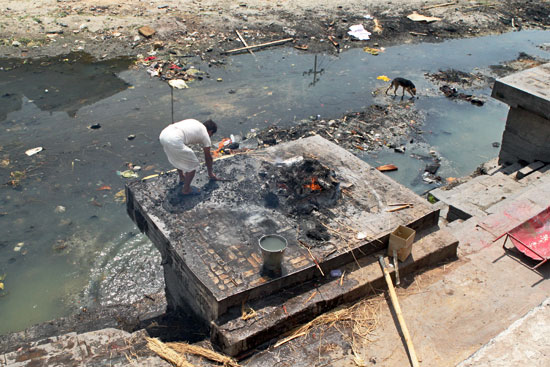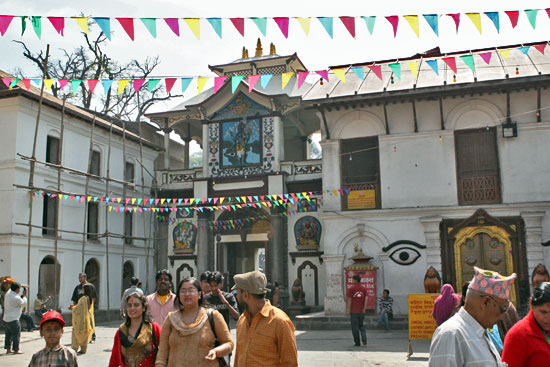My second annual visit to Nepal’s capital city was less stressful. I knew what to expect and was familiar enough with the city to find my way around. This time I vowed to see all five remaining UNESCO World Heritage Sites in Kathmandu that I had missed the previous year, beginning with Swayambhunath Buddhist Stupa. I hopped on the back of a friend’s motorcycle and we wove our way through Kathmandu’s massive traffic jams to the hilltop site.

Swayambunath’s main feature is the Maha Stupa, reputed to be more than 2,000 years old. It’s brilliant white dome, which represents the spotless pure jewel of Nirvana (freedom from the endless cycle of reincarnations), is topped by a 13-tier golden spiral tower. Between the dome and the tower the traditional all-seeing eyes, painted on all four sides of the stupa, gaze out over miles of the city. It’s stylized lotus mandala base is said to be built on the precise spot where the Chinese saint Manjushri saw the flaming lotus floating on the lake that legend says once covered the Kathmandu Valley. Desiring to worship the lotus, Manjushri cut a swath in the hills that surround Kathmandu with his giant sword, draining the lake.
Over the years, hundreds of votive shrines and other historical monuments have sprung up around the central stupa, including a magnificent two-tiered golden temple dedicated to Harati who, according to legend, was an ogress until Lord Buddha converted her to the caretaker of children. Not far from this temple is Dewa Dharma Monastery, where a bronze Buddha icon and many fine Tibetan paintings are on display. At the top is a huge gold-plated vajra, a Buddhist symbol that represents the nature of reality. Strangely, with all this opulence on display the thing that most defines Swayambhunath are the herds of monkeys that roam freely over the site. Though I enjoyed the monuments and views, the food-stealing and children-harassing antics of the monkeys were the most entertaining aspect of my visit to the site that is ore commonly referred to as the Monkey Temple.
Patan Durbar Square, the next on my list of UNESCO World Heritage Sites, is the second of three ancient Royal Palaces built by competing kingdoms within the Kathmandu Valley. The site contains more than 30 monuments in a relatively small urban area, with another 30 in close proximity. The renowned French orientalist called it “a marvel beyond the power of words to tell,” and indeed the effect when I first saw it was overwhelming. I didn’t know where to look first, so I started with a visit to the Patan Museum, housed in one of the royal palaces of the former Malla Kings. The majority of the exhibits are sculptures of Hindu and Buddhist deities, many of which were crafted in the workshops of Patan. The exhibits are well documented in English and explain the spiritual and artistic significance of each piece, while also relating the history of the artworks to the living culture outside the museum walls.

After a couple of hours in the museum, I understood that Patan Durbar Square is the best example of the architecture of indigenous Newari, who were such great artisans that the conquerors adopted their architectural style for its sheer beauty. Back out on the street I examined the intricately carved windows and doors of Newari-style buildings, no two of which are alike. It is widely believed that Newar architects were responsible for developing the hallmark multi-tiered style of pagoda so prevalent in Asia, and they are credited with introducing the lost-wax technique into Bhutan. Today, Patan is renowned as a art center and one of the best places in the Kathmandu Valley to purchase fine ancient art, metallic and stone carvings, and hand-carved woodworking.
Having visited two of the sites on my hit list with no stress, I decided to visit the next two, Boudhanath Temple and Pashupatinah Temple, in one day. And that’s when things began to fall apart. Boudhanath, one of the oldest and largest Buddhist stupas ever built in Nepal, is said to have been constructed around the 5th century AD. For Tibetan Buddhists the site is akin to Mecca for Arabs; tens of thousands from the Himalayan region make the pilgrimage to Boudhanath each year. Stories abound about the genesis of the stupa, and Tibetan lore differs significantly from Nepali. Tibetans believe that an old poultry woman petitioned the king to provide her land upon which she wished to construct a religious site. The king agreed to give her as much land as she could cover with the hide of a water buffalo. Undeterred, the woman cut a buffalo hide into thin strips and laid them end-to-end, encircling a large plot of land. Though the king realized he had been tricked, he kept his word.

Nepali legend relates quite a different story. One of the early kings in the Kathmandu Valley constructed a fountain near his palace but water refused to pour from the three stone spouts. He consulted the oracles, who advised that a pure man who possessed the thirty-two virtues must be sacrificed at the spot. The king summoned his son and commanded him to go to the spring early the next morning and behead the shrouded person he would find sleeping there. The prince did as he was instructed, only to find, to his horror, that he had slain his own father. To atone for his sin, the prince had the great stupa built.
Though there is disagreement about its origin, everyone agrees that a wondrous sense of peace and serenity impregnate the site. The moment I stepped from the noisy, congested alley leading to the stupa, energy shifted. Tibetan prayer flags flapped in the wind. The soft whiz of spinning prayers wheels reverberated throughout the courtyard. I climbed to the upper level of the stupa, where I began my three circumnavigations, adding my softly chanted “om mani padme hum” to those of a hundred others. Enchanted, I snapped dozens of photos. Behind me, a crimson-robed monk was prostrating, so I reversed direction. The monk stood up and frowned at me, clearly irritated. In my quest for an image that would perfectly convey the devotion I was witnessing, I had completely forgotten that circumnavigations must always be done in a clockwise direction. Thoroughly embarrassed and ashamed of myself, I quickly descended from the stupa and hopped in a taxi, bound for the famous Hindu temple, Pashupatinath.
Considered to be one of the holiest of all Hindu shrines, this pagoda-style temple with gilt roof and ornately carved silver doors is dedicated to Lord Shiva. Though I had read that only Hindus could enter the temple, a Nepali friend had insisted that Buddhists were also allowed inside. However when I arrived, two large yellow and red signs bracketing the temple doors to the temple declared the site off-limits to non-Hindus. Instead, I contented myself with a tour of the grounds and cremation ghats, where thick black smoke from burning bodies wafted over the reeking, trash-choked Bagmati River.

Circuiting back to the temple entrance, my curiosity got the better of me. “What’s the worst that could happen?” I thought. I mingled with a large group and passed through the doors, where a giant bronze statue of Nandi, the mount of Shiva, dominated the open courtyard. Entranced, I didn’t notice the two uniformed guards rushing toward me until they twirled me around and, each grabbing me by an arm, forcibly ejected me from the grounds, oblivious to my plea: “But I am a Buddhist!”

Despite my latest unnerving experiences, I was determined to visit the seventh and final UNESCO World Heritage Site, Bhaktapur Durbar Square, especially since Nepali New Year would be celebrated there the following day. But the next morning I woke to severe diarrhea. “Serves me right,” I thought. “It’s punishment.” As soon as I was well enough to unchain from the toilet I bought a bus ticket to Pokhara. Bhaktapur would have to wait until my next visit.
Next: How I nearly died during the Biset Jatra (New Year) celebration at Bhaktapur Durbar Square.

Ahhh – Kathmandu…I have a similar love/hate. I think I only love it though becuase it means that I’m in Nepal and will get to do some trekking!
wow!!!
nice blog
Holiday Trekking in Nepal
Boudhanath Stupa is realy stupendous view. I can only imagine what must be the feeling standing in front of this majestic, multicoloured construction. There must be really strong energy vibration around I am guessing.
Boudhanath IS spectacuar, especially since it’s surrounded by many monasteries. The next time I arrive in Kathmandu I plan to stay art Shechen Monastery, which is just steps away from the Stupa.
Sounds like such an intriguing place! Sorry it didn’t all turn out the way you had hoped though!
There is no other beautiful place that can equal to this place. Such a great heritage.
Wonderful story and pictures!
Thank you David – one more in this series of articles to go, year three, and this time I nearly died. Stay tuned.
Hello Barbara,
great post and storry. I would love to travel one day to Kathmandu! What was so stressful in your first visit? Greetings from Costa Rica
Hi Tobias: Here’s the article about year one: https://holeinthedonut.com/2012/06/09/kathmandu-nepal-unesco-world-heritage-sites1 .
http://goo.gl/XdcYS